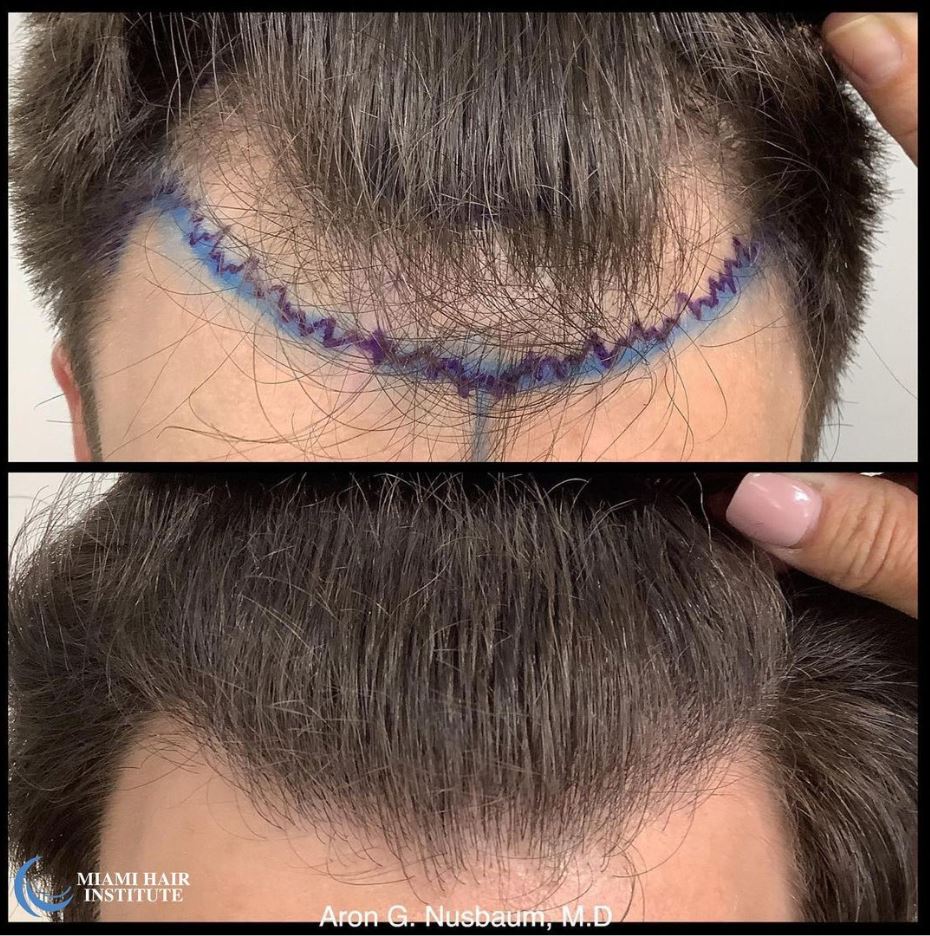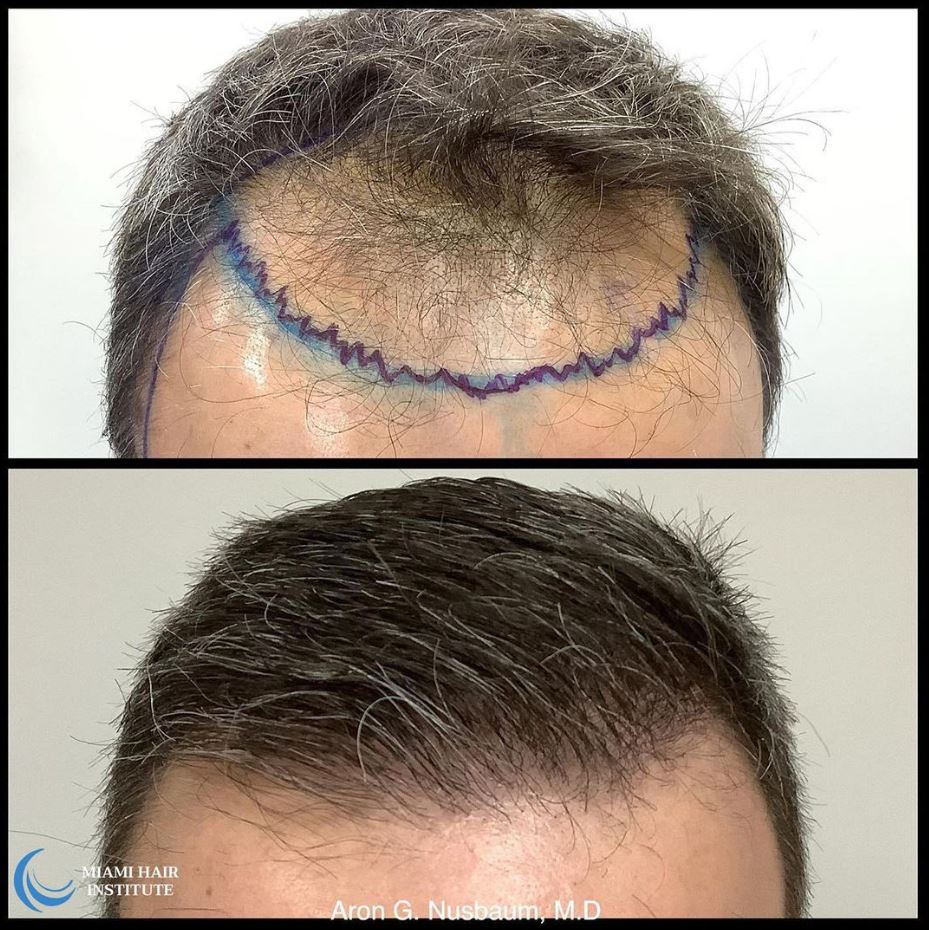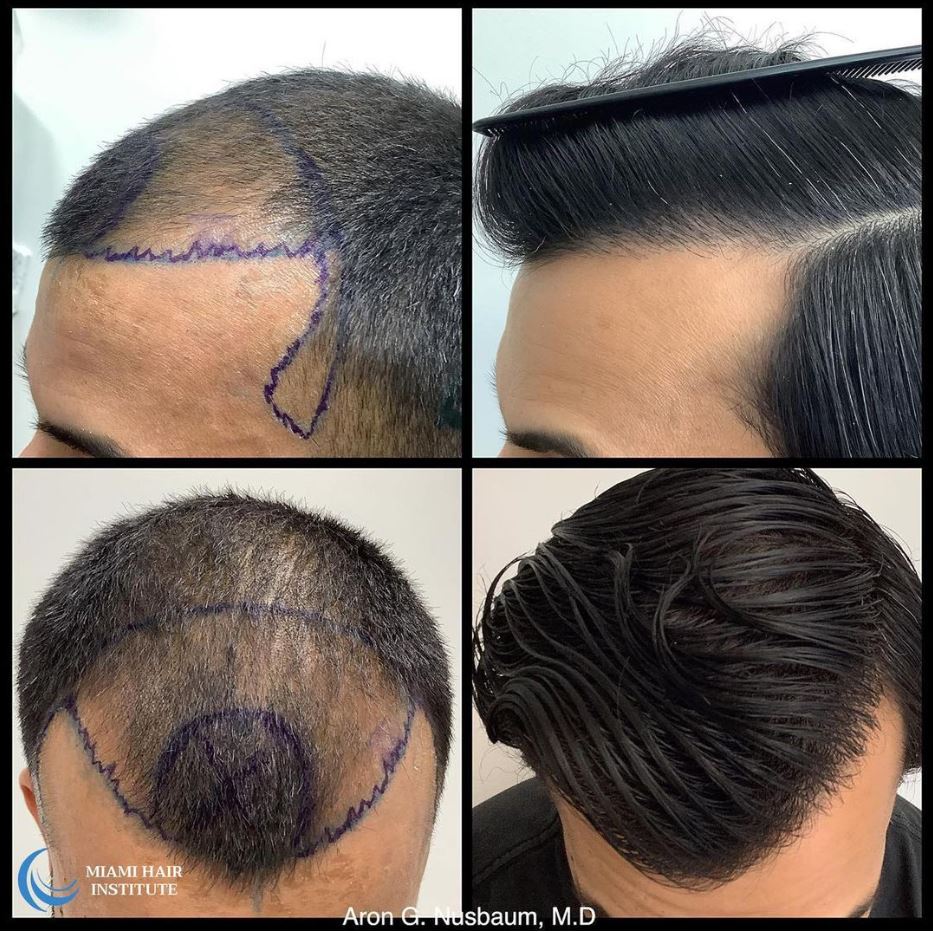This guide explores the ARTAS procedure, benefits, recovery timeline, and factors influencing natural-looking results. Find out if you’re a candidate.

When it comes to all things ARTAS, Miami Hair Institute is a leading authority in the practice. We are the #1 ARTAS hair transplant center in the United States with over 1,000 ARTAS procedures performed. If you’re contemplating getting a hair transplant in Miami and want to learn everything there is to know about ARTAS, we’re here to answer all your questions.
What is ARTAS?
ARTAS transplant is an advanced procedure utilizing robotics and digital imaging for precise hair follicle harvesting and transplantation. The ARTAS system uses a robotic arm and an advanced digital imaging for a more precise and minimally invasive approach.

Dr. Nusbaum performs an FUE hair transplant with the assistance of the ARTAS iX™ Robotic Hair Restoration System. Watch Dr. Nusbaum explain ARTAS hair transplant.
How ARTAS Hair Transplant Works
3D Imaging & Planning: A 3D scan of the scalp creates a detailed map of healthy donor follicles and the recipient area (balding area). This allows for meticulous pre-operative planning, including designing a natural-looking hairline.

Dr. Timothy Wu utilizes the minimally-invasive ARTAS Robotic System for a patient’s FUE procedure.
Robotic Follicle Harvesting: The ARTAS system uses high-definition cameras and intelligent algorithms to identify and select the healthiest follicular units for transplantation. The robotic arm then meticulously harvests these follicles with minimal disruption to surrounding tissue.
Recipient Site Preparation: The surgeon prepares tiny recipient sites in the balding area using a very fine needle. Here’s where the 3D map proves valuable, ensuring optimal placement for a natural outcome.
Follicle Implantation: The harvested grafts are then carefully implanted into the recipient sites by the surgeon. The precision of the procedure ensures minimal damage and maximizes graft survival.
Related article: Is Robotic Hair Transplant Better than Manual FUE?
Benefits of ARTAS Robotic Hair Transplant
With ARTAS, you experience many advantages not found in traditional hair transplant methods. This includes:
- Minimal Scarring: Unlike the linear scars often associated with FUT, ARTAS takes a minimally invasive route, leaving you with little to no visible scarring. This opens up a world of styling possibilities, even if you prefer shorter hairstyles.
- Faster Recovery Time: The robotic harvesting process minimizes tissue trauma. This results in faster healing and shorter downtime. In just a matter of days, you’ll find yourself back to your usual routine, whether it’s work or other activities.
- Precise Follicle Harvesting: ARTAS employs advanced algorithms to select the healthiest hair follicles for transplantation. This increases the likelihood of graft survival and a natural appearance.
- Natural-Looking Hairline: Your new hairline will look as if it’s always been there. Through 3D imaging and meticulous graft placement, your surgeon can create a personalized hairline that seamlessly blends with your existing hair, giving you a natural look that enhances your appearance.
- Reduced Risk of Complications: The minimally invasive nature of ARTAS means you’re less likely to experience bleeding, infection, or other complications often associated with traditional techniques.

Dr. Aron Nusbaum and Dr. Timothy Wu perform an FUE hair transplant procedure for a male patient using the #ARTAS Robotic System. With ARTAS Robotics, graft quality is consistent throughout the procedure. This helps to provide greater precision and accuracy during the procedure.
Who is a Good Candidate for ARTAS?
ARTAS is a great option for men and women experiencing various types of hair loss. However, it is most suitable for individuals with:
- Stable hair loss pattern
- Sufficient donor area with healthy hair follicles
- Realistic expectations for hair restoration
- Good overall health
ARTAS Recovery Timeline
The ARTAS recovery timeline is similar to manual FUE. However, it’s important to remember that recovery can vary from person to person. Here’s what you can expect after your hair transplant procedure:
Immediately Following the Procedure
- You’ll be monitored for a short period before being discharged home with detailed post-operative instructions.
- Expect mild discomfort, swelling, and redness in the treated areas. These effects typically peak within the first 24-48 hours and gradually subside within a few days.
- Cooling compresses can help alleviate swelling and discomfort. When necessary, you can also use pain medication prescribed by your surgeon.
Days 1-7
- The scabbing around the transplanted follicles will begin to form. But this is not something to worry about. It is a normal part of the healing process.
- Avoid strenuous activity or exercise that could cause sweating or increased blood pressure.
- You can resume light activities like walking or desk work.
Days 7-10
- The scabs will start to loosen and naturally fall off. Avoid picking or scratching at the scabs, as this can dislodge the transplanted follicles.
- You can resume normal hair washing, following the specific instructions provided by your surgeon. This typically involves using a gentle shampoo and avoiding harsh rubbing.
- You may notice some initial shedding of the transplanted hair. This is a normal part of the hair growth cycle as the transplanted follicles adjust to their new location.
Weeks 2-4
- The shedding of transplanted hair should subside.
- The treated areas may still feel slightly tender to the touch. This is normal and should gradually improve over time.
- You can generally resume most activities, but it’s still advisable to avoid activities that could put undue stress on the scalp.
Months 3-6
- New hair growth should begin to appear in the transplanted areas. This growth may be fine and vellus-like initially, but it will gradually thicken and become more noticeable.
- Be patient, as it can take several months to see the full results of the transplant.
Months 6-12
- Continued hair growth can be expected, with the transplanted hair becoming increasingly thicker and denser.
- You should see a significant improvement in your overall hair density and a natural-looking hairline by around the 12-month mark.
Does ARTAS Hair Transplant Ensure a Natural Appearance?
ARTAS undoubtedly assists your surgeon in many ways, such as precise follicle harvesting and 3D imaging for designing a customized hairline. But whether or not you will have natural-looking results relies on your surgeon.
It’s your surgeon’s expertise, experience, and artistry that ultimately determine the outcome. They must interpret the data provided by ARTAS accurately and make decisions during the transplantation process to ensure the most natural-looking results. Factors such as graft placement, angle, and density require careful consideration and meticulous execution to achieve a seamless blend with your existing hair and facial features.
Which is why selecting a qualified surgeon is arguably the most important step in your hair transplant journey. We recommend doing your research first before getting the procedure.
Commonly Asked Questions about ARTAS Transplant
How long does ARTAS last?
The results of an ARTAS hair transplant are typically permanent. This is because the donor hair are resistant to balding. Once the transplanted hair follicles take root, they continue to grow like your natural hair.
What is the success rate of ARTAS?
The success rate of ARTAS hair transplants is generally high (about 90% or higher depending on your surgeon’s skill. Most patients experience successful hair growth and achieve the desired aesthetic outcome.
Does ARTAS leave scars?
ARTAS uses a minimally invasive approach, which means it leaves minimal to no visible scarring. Unlike traditional methods like FUT, you won’t have to worry about noticeable scars on your scalp.
How much does ARTAS hair transplant cost?
The cost of an ARTAS hair transplant can vary depending on the extent of hair loss and the number of grafts needed. We recommend consulting with a qualified provider to get an accurate estimate based on your specific needs. Find answers to your questions here.
Schedule a Consultation at the #1 ARTAS Hair Transplant Center in the US.
It’s not a secret. Miami Hair Institute is the leading ARTAS hair transplant provider in the United States. We have performed over a thousand ARTAS procedures and surgeons have consistently produced amazing results.
Call us to book a consultation with our hair transplant surgeons today. We are conveniently located at 3850 Bird Road, Suite 102, Miami, FL 33146, serving patients in the South Florida area, including Miami, Coral Gables, Miami Beach, Gladeview, South Miami, and more.
ARTAS Robotic Hair Transplant Before and After Photos
Look at these life-changing hair transplant results. To see more amazing transformations like this, head to our before and after gallery.

1,942 follicular units with ARTAS robotic FUE at 12 months

2,181 follicular units via ARTAS robotic FUE at 1 year. Naturalness and density in on procedure.

2,106 follicular units with ARTAS robotic FUE at 1 year. Note the naturalness and density of this result which is particularly impressive given the patients dark hair and light skin.

